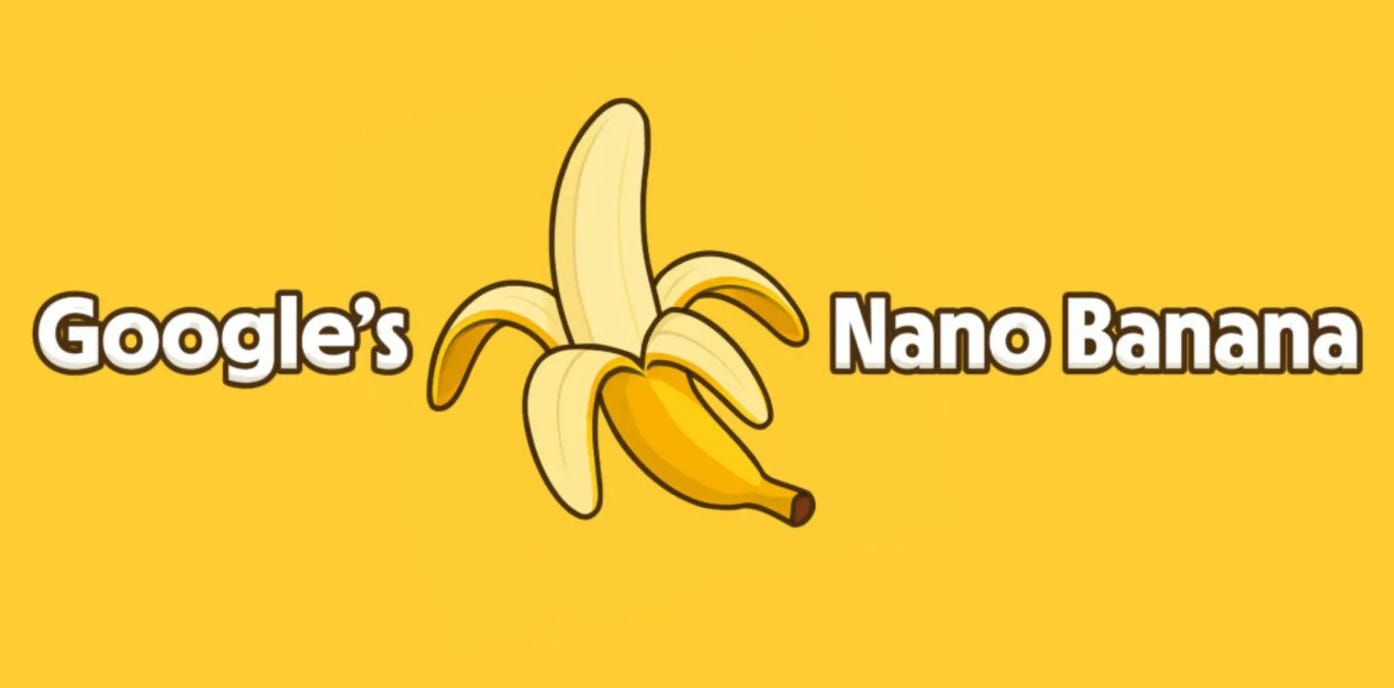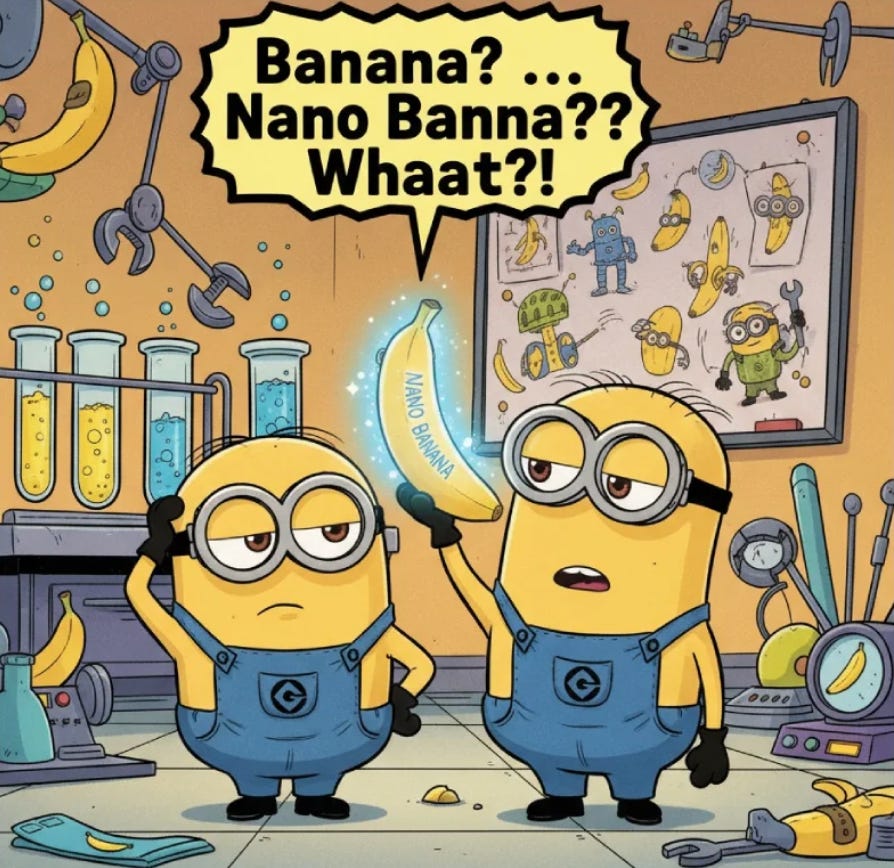The Visual Product Manager
How AI Image Tools Are Redefining PM Communication
In our last deep dive, we explored how AI is reshaping the PM role itself — from orchestrating humans + AI systems to becoming outcome-driven leaders. Today, let’s zoom into one of the most underrated but fast-moving shifts: how PMs communicate.
The rise of AI image tools isn’t just about pretty pictures. It’s about changing the very language of product management from text-first to visual-first. And that change is already here.
Remember When…
Remember when mockups took weeks and cost thousands? When you had to "sell" your product vision through endless PowerPoint slides and hope stakeholders could visualize what you meant?
Those days are officially over.
👉 The shift: PMs are becoming visual storytellers, not just requirement writers. And it's happening faster than anyone expected.
🎨The Nano Banana Moment: Why Google's Launch Changes Everything
Google just dropped Nano Banana, their new AI image editor, and while the internet laughed at the name, smart PMs are studying the strategy. Because Nano Banana isn't just another photo tool—it's both a glimpse into how PMs will communicate in 2026 AND a masterclass in product strategy.
Here's what caught our attention: Instead of describing product concepts, PMs can now show them. Real-time. In context.
Example: Instead of writing "We need a more intuitive checkout flow," you can now:
Take a screenshot of your current checkout
Use Nano Banana to visually prototype the new flow
Show stakeholders the exact experience in 30 seconds
The result? Visual requirements that eliminate most back-and-forth clarification.
But here's why this matters beyond just faster mockups…
🎯 The Strategy Lessons Every PM Should Learn
When Google dropped Nano Banana, most people laughed at the name. Memes flew, tweets trended, and the internet debated whether this was Google being quirky or just plain weird.
But here's the thing: Nano Banana isn't a joke — it's a product strategy masterclass that perfectly illustrates how the best PMs should think about visual communication.
Lesson 1: Sell Outcomes, Not Features Google didn't market Nano Banana as "an advanced AI model for image editing." That would have been boring and forgettable. Instead, they showed what it enables:
Consistent edits across multiple images
Multi-step, natural language editing
Seamless style blending and transformations
The focus wasn't on the what — it was on the so what. This is exactly how visual PMs should communicate: show the outcome, not the feature.
Lesson 2: Meet Users Where They Already Are Google didn't release Nano Banana as a standalone app. They dropped it straight into Gemini (where millions already engage with AI) and extended it via APIs for developers.
This is adoption strategy 101 — and it's the same principle visual PMs should follow. Don't force stakeholders to learn new tools. Bring visual communication into their existing workflows: Slack screenshots, Figma comments, email mockups.
Lesson 3: Make It Impossible to Ignore "Nano Banana" is funny, sticky, memorable, and viral. It cut through a sea of dull technical names and made people care enough to click, read, and try.
The PM parallel: Your visual communications need to grab attention too. A compelling mockup beats a boring bullet list every time.
Lesson 4: Anticipate and Address Risks Google knew AI image editing has risks: deepfakes, misinformation, reputational damage. So they shipped Nano Banana with SynthID watermarks built in—safety wasn't bolted on later.
For visual PMs: Every mockup has potential misinterpretation. Address the "dark side" upfront: technical complexity, accessibility concerns, edge cases.
Lesson 5: Serve Multiple Audiences Simultaneously Nano Banana works for casuals in Gemini, power users with complex workflows, AND developers needing APIs. One launch, three adoption vectors.
The visual PM version: Your mockups should speak to engineering (technical feasibility), design (user experience), AND business (market impact) simultaneously.
📊 Why This Shift Is Happening Now
The data shows we're at a tipping point. Recent research reveals the communication crisis that's driving PMs toward visual solutions:
90% of business leaders agree generative AI has improved the quality of visual communication
77% say communicating visually has increased business performance, whether it's accelerating content creation, more engagement, or better collaboration
“PMs who can show instead of tell will always get alignment faster.” — Shreyas Doshi
🧠 The Visual-First PM Playbook
Now that we understand WHY this shift is happening, let's talk about HOW to make it work. The best PMs are already adapting with these three core strategies:
1. The 30-Second Prototype Rule
Before writing any PRD, spend 30 seconds creating a visual mockup. If you can't show it quickly, you probably can't explain it clearly.
This connects directly to Nano Banana's lesson about outcomes over features. Don't describe what you want—show what success looks like.
Tools that make this possible:
Nano Banana (Google) - Real photo editing for context
Figma AI - UI component generation
Midjourney - Concept visualization
Adobe Firefly - Brand-consistent imagery
Canva AI - Lightweight visuals for stakeholders
Runway - Motion/UX video prototypes
2. Context-Driven Requirements
Instead of abstract user stories, create visual user stories that show the actual user experience.
Before: "As a user, I want to easily find products so I can make purchases faster."
After: [Visual mockup showing the exact search interface + user flow with AI-generated context]
This mirrors Nano Banana's approach of meeting users where they are—your visuals should meet stakeholders in their actual decision-making context.
💡 The Bottom Line: From Nano Banana to Your Next Launch
Visual communication isn't replacing PM skills—it's amplifying them.
Google's Nano Banana launch shows us the future: PMs who master visual storytelling will ship faster, align teams better, and create products users actually want. The lessons are clear:
Lead with outcomes (show the "so what," not the "what")
Ship where users already are (integrate into existing workflows)
Make your product impossible to ignore (memorable beats forgettable)
De-risk before critics pounce (address the dark side upfront)
Serve multiple audiences with one release (engineering, design, and business simultaneously)
The question isn't whether you should become a "Visual PM." The question is: how quickly can you start?
🔍 The Visual PM in 5 Seconds
Uses AI tools to communicate outcomes visually
Shows mockups in 30 seconds, not 3 weeks
Meets stakeholders in their existing workflows
Grabs attention with clarity & creativity
Anticipates risks (misinterpretation, accessibility, ethics)
For further reading, check out the official resources:
This Week's Featured Job Openings
Company: Fortune Brands Home & Security
Location: Deerfield, IL
Company: Superblocks
Location: New York, NY
Company: Postman
Location: San Francisco, CA
Company: DISQO
Location: Los Angeles, CA
Director of Product Management
Company: PlayStation
Location: Bellevue, WA
Stay tuned each week as we bring you new opportunities. Happy job hunting.



